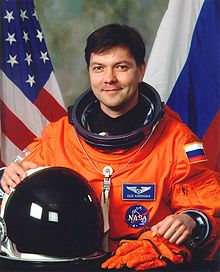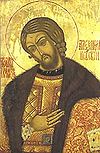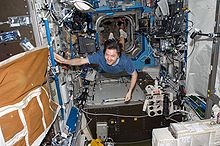- Oleg Kononenko
-
Oleg Dmitriyevich Kononenko 
RKA Cosmonaut Nationality Russian Status Active Born June 21, 1964
Chardzhou, Turkmen SSROther occupation Engineer Rank Civilian Time in space 198d 16h 20m Selection 1996 RKA Group Total EVAs 2 Total EVA time 12 hours 12 minutes Missions Soyuz TMA-12, Expedition 17 Mission insignia 

Awards Oleg Dmitriyevich Kononenko (Russian: Олег Дмитриевич Кононенко) is a Russian cosmonaut.[1]
Contents
Personal
Kononenko was born June 21, 1964, in Chardzhou, Turkmen SSR. He is married to Tatiana Mikhailovna Kononenko (née Yurieva). They have a son, Andrey Olegovich Kononenko, and a daughter, Alisa Olegovna Kononenko. Kononenko enjoys reading, and team sports.
Education
Kononenko graduated from the N. E. Zhukovskiy Kharkov Aviation Institute in 1988 as a mechanical engineer.[1]
Awards
Kononenko was awarded the Hero of the Russian Federation medal and the Yu. A. Gagarin Medal of the Cosmonautics Federation, Russia.
Experience
After graduation, Kononenko worked at the Russian Space Agency’s Central Specialized Design Bureau TsSKB-Progress in Kuybishev, starting as an engineer and working his way up to leading design engineer. His responsibilities included system design, analysis, and development of spacecraft electrical power systems.[1]
Cosmonaut career
On March 29, 1996, Oleg was selected as a cosmonaut candidate by the Interagency Committee, and from June 1996 to March 1998, he underwent cosmonaut training at the Gagarin Cosmonaut Training Center and on March 20, 1998, was awarded the title of test cosmonaut by the Interagency Qualification Committee.[1] In October 1998 he began training as part of the group of cosmonauts selected for the International Space Station (ISS) Program.[1]
From December, 2001, through April 2002, Kononenko trained as a backup flight engineer for the Soyuz TM-34 vehicle for the third ISS visiting crew. From March 2002, through February 2004, he trained as the flight engineer for the Soyuz TMA vehicle and the Expedition 9 and Expedition 11 primary crews. From March 2004 through March 2006, he trained as part of the group of cosmonauts selected for the ISS Program. In March 2006, Kononenko began training as a flight engineer for the Soyuz TMA-12 vehicle and the Expedition 17 crew.[1]
Expedition 17
Kononenko was a Flight Engineer on both the Expedition 17 mission to the International Space Station, and the Soyuz TMA-12 mission that flew him there. The crew launched on April 8, 2008, and landed on October 24, 2008.[1] Kononenko spent 199 days in space.[2]
Kononenko returned to Earth with Expedition 17 commander Sergei Volkov, and spaceflight participant Richard Garriott (who launched aboard Soyuz TMA-13 to the ISS on October 12, 2008 with the Expedition 18 crew).[3][4] They landed at 11:37 p.m EDT 55 miles north of Arkalyk, Kazakhstan. They were flown to the Baikonur Cosmodrome by helicopter, and then went on to Zvezdny Gorodok (Star City), Moscow.[5][6][7]
Spacewalks
Kononenko conducted his first spacewalk on July 10, 2008 when he ventured into space from the Pirs docking compartment airlock of the ISS.[8] He and cosmonaut Volkov inspected their Soyuz TMA-12 spacecraft and retrieved a pyro bolt from it. This spacewalk lasted 6 hours and 18 minutes.
On July 15, Kononenko again went outside from Pirs to conduct his second spacewalk.[9] Kononenko and Volkov installed one experiment and retrieved another. They also continued to outfit the station's exterior, including the installation of a docking target on the Zvezda service module. The spacewalk was in Russian Orlan suits and Kononenko wore an Orlan suit with blue stripes. The spacewalk lasted 5 hours and 54 minutes.
References
- ^ a b c d e f g NASA (2008). "Oleg Dmitrievich Kononenko". NASA. http://www.jsc.nasa.gov/Bios/htmlbios/kononenko.html. Retrieved October 25, 2008.
- ^ NASA (2008). "Expedition 17". NASA. http://www.nasa.gov/mission_pages/station/expeditions/expedition17/index.html. Retrieved October 25, 2008.
- ^ Mark Carreau (2008). "$30 million buys Austin resident a ride on Soyuz mission". The Houston Chronicle. http://www.chron.com/disp/story.mpl/front/6052360.html. Retrieved October 12, 2008.
- ^ Tariq Malik. "Former Astronaut's Son Signs on as Next Space Tourist". SPACE.com. http://www.space.com/news/070928_garriott_spacetourist.html. Retrieved October 9, 2007.
- ^ BBC (October 24, 2008). "Soyuz space capsule lands safely". BBC News. http://news.bbc.co.uk/2/hi/science/nature/7688021.stm. Retrieved October 25, 2008.
- ^ ITAR (2008). "Cosmonauts examined with special system". ITAR-TASS News Agency. http://www.itar-tass.com/eng/level2.html?NewsID=13204951&PageNum=0. Retrieved October 25, 2008.
- ^ Peter Leonard for the Associated Press (2008). "US Game Designer Blasts Into Space With DNA Cargo". ABC News. http://abcnews.go.com/Technology/wireStory?id=6014658. Retrieved October 25, 2008.[dead link]
- ^ NASA (July 10, 2008). "Russian Spacewalkers Retrieve Soyuz Pyro Bolt". http://www.nasa.gov/mission_pages/station/expeditions/expedition17/eva20a.html. Retrieved June 3, 2010.
- ^ NASA (July 15, 2008). "Russian Spacewalkers Outfit Station's Exterior". http://www.nasa.gov/mission_pages/station/expeditions/expedition17/eva20.html. Retrieved June 3, 2010.
External links
People from Russia Leaders and religious - Pre-1168
- 1168–1917
- 1922–1991
- 1991–present
- RSFSR leaders
- General secretaries
- Soviet premiers (1st deputies)
- Soviet heads of state (and their spouses)
- Prime ministers (1st deputies)
- Foreign ministers
- Prosecutors general
- Metropolitans and patriarchs
- Saints

Military and explorers - Field marshals
- Soviet marshals
- Admirals
- Aviators
- Cosmonauts
Scientists and inventors - Aerospace engineers
- Astronomers and astrophysicists
- Biologists
- Chemists
- Earth scientists
- Electrical engineers
- IT developers
- Linguists and philologists
- Mathematicians
- Naval engineers
- Physicians and psychologists
- Physicists
- Weaponry makers
Artists and writers Sportspeople Chess playersCategories:- 1964 births
- Living people
- People from Lebap Province
- Russian cosmonauts
- Crew members of the International Space Station
Wikimedia Foundation. 2010.


